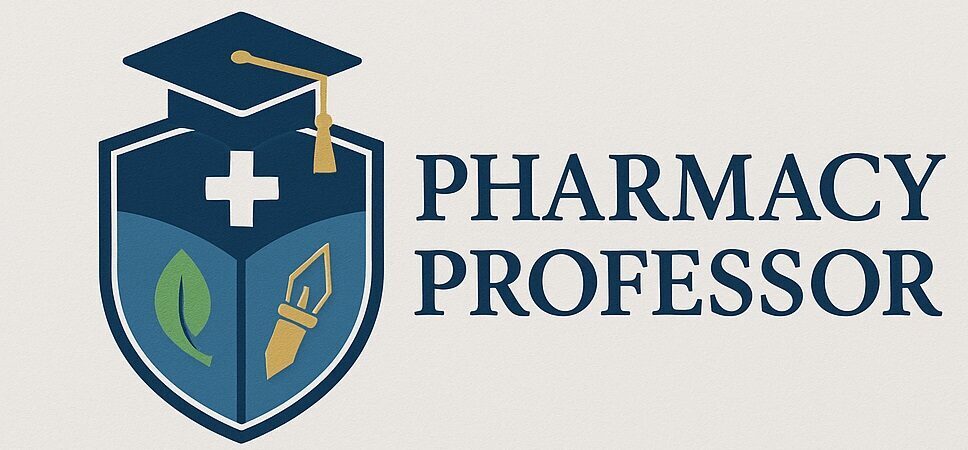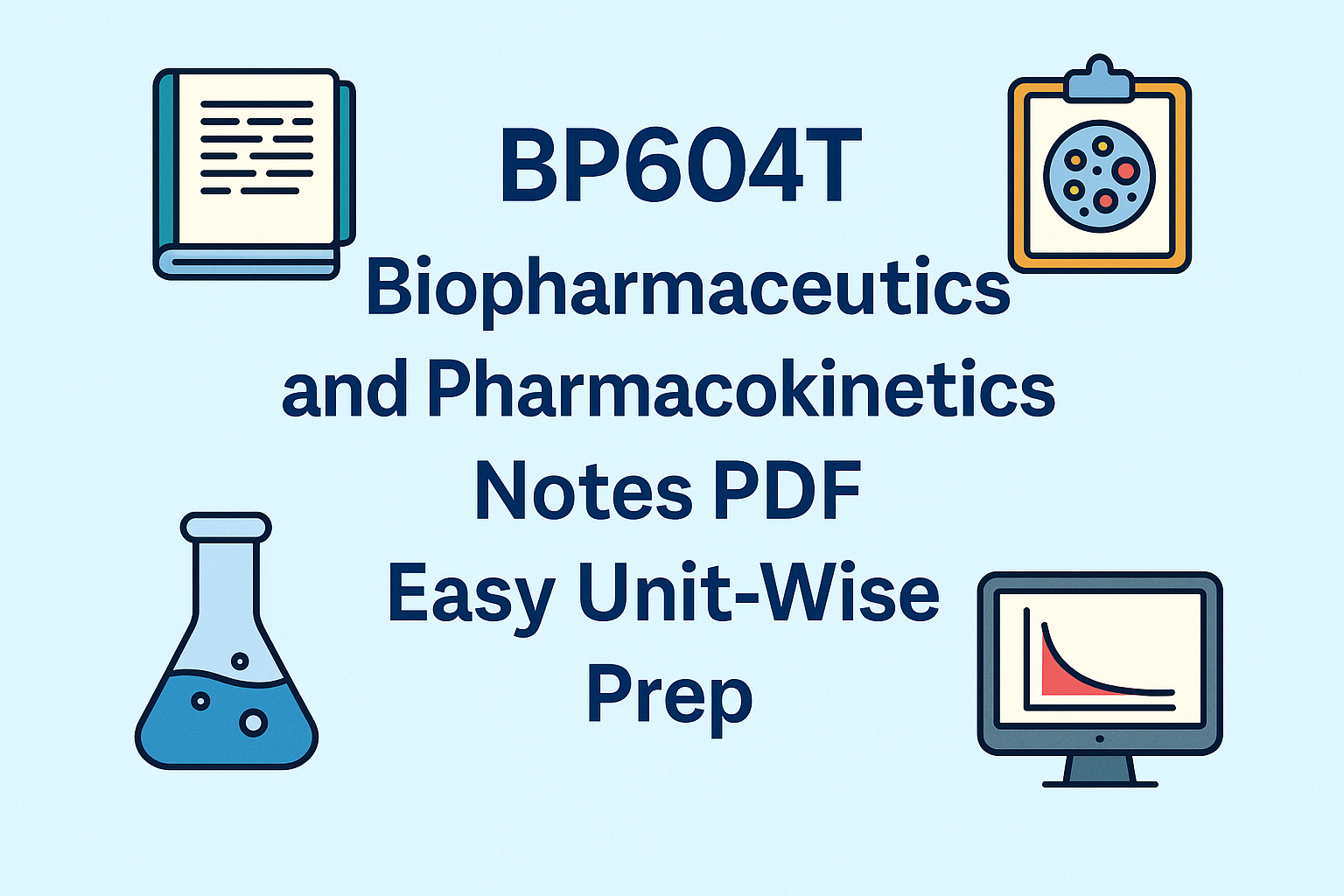Introduction
We get it—BP604T (Biopharmaceutics and Pharmacokinetics) can feel tough. It’s packed with complex concepts and lots of calculations that can be confusing at first. But don’t worry—we’re here to help!
To make your exam prep easier, we’ve created unit-wise handwritten notes in PDF format. These notes are:
✅ Easy to understand
✅ Exam-oriented
✅ Based on the latest PCI syllabus
Whether you’re short on time or just want to revise smarter, these notes are perfect for quick and clear learning.
What is BP604T – Biopharmaceutics and Pharmacokinetics?
BP604T is a key subject that explains how drugs behave in the body—covering absorption, distribution, metabolism, and excretion (ADME). It also includes pharmacokinetic modeling, dosage calculations, and factors that influence bioavailability and therapeutic effectiveness.
🎯 Learning Outcomes of BP604T – Biopharmaceutics and Pharmacokinetics
By the end of this subject, you will be able to:
- ✅ Understand how drugs move in the body – Learn how drugs are absorbed, distributed, metabolized, and excreted (ADME process).
- ✅ Explain the factors affecting drug bioavailability – Know what influences the rate and extent of drug absorption.
- ✅ Describe the concept of bioequivalence – Understand how generic drugs are compared with branded ones.
- ✅ Apply pharmacokinetic models – Get familiar with one-compartment and multi-compartment models used to describe drug behavior.
- ✅ Solve pharmacokinetic problems – Use formulas to calculate drug concentrations, half-life, clearance, volume of distribution, and more.
- ✅ Correlate in vitro and in vivo data (IVIVC) – Understand how lab test results relate to actual drug performance in the body.
- ✅ Interpret data for dosage adjustments – Learn how to adjust doses in special cases like kidney or liver impairment.
Download BP604T Unit-Wise Handwritten Notes PDF
Each unit is available in a clear, concise handwritten PDF format for fast revision and better retention.
Unit 1: Introduction to Biopharmaceutics
Absorption; Mechanisms of drug absorption through GIT, factors influencing drug absorption though GIT, absorption of drug from Non per oral extra-vascular routes, Distribution Tissue permeability of drugs, binding of drugs, apparent, volume of drug distribution, plasma and tissue protein binding of drugs, factors affecting protein-drug binding. Kinetics of protein binding, Clinical significance of protein binding of drugs
Unit 2: Drug Distribution and Elimination
Elimination: Drug metabolism and basic understanding metabolic pathways renal excretion of drugs, factors affecting renal excretion of drugs, renal clearance, Non renal routes of drug excretion of drugs
Bioavailability and Bioequivalence: Definition and Objectives of bioavailability, absolute and relative bioavailability, measurement of bioavailability, in-vitro drug dissolution models, in-vitro-in-vivo correlations, bioequivalence studies, methods to enhance the dissolution rates and bioavailability of poorly soluble drugs.
Unit 3: Pharmacokinetics – One Compartment Model
Pharmacokinetics: Definition and introduction to Pharmacokinetics, Compartment models, Non compartment models, physiological models, One compartment open model. (a). Intravenous Injection (Bolus) (b). Intravenous infusion and (c) Extra vascular administrations. Pharmacokinetics parameters – KE ,t1/2,Vd,AUC,Ka, Clt and CLR- definitions methods of eliminations, understanding of their significance and application
Unit 4: Multicompartment models
Two compartment open model. IV bolus Kinetics of multiple dosing, steady state drug levels, calculation of loading and maintenance doses and their significance in clinical settings.
Unit 5: Nonlinear Pharmacokinetics
Nonlinear Pharmacokinetics: a. Introduction, b. Factors causing Non-linearity. c. Michaelis-menton method of estimating parameters, Explanation with example of drugs
Why Use These Notes?
Advantages:
- ✅ PCI syllabus B.Pharm & M.pharm covered
- ✅ Handwritten, clean, and easy to revise
- ✅ Focused on frequently asked exam questions
- ✅ Suitable for quick revision & GPAT concepts
- ✅ Helpful for viva and practical applications
BP604T Syllabus Overview
| Unit | Topics |
|---|---|
| Unit 1 | ADME, Drug Absorption |
| Unit 2 | Distribution, Elimination, Half-life |
| Unit 3 | Pharmacokinetics One-compartment Kinetics |
| Unit 4 | Multicompartment models |
| Unit 5 | Nonlinear Pharmacokinetics |
Best Reference Books for BP604T
- Biopharmaceutics and Clinical Pharmacokinetics – Milo Gibaldi
- 👉 A classic and globally recognized textbook. Best for building strong conceptual understanding, especially in clinical pharmacokinetics.
- Biopharmaceutics and Pharmacokinetics – Robert F. Notari
- 👉 Great for clear explanations and step-by-step mathematical problem-solving. Ideal if you’re looking for a student-friendly approach.
- Applied Biopharmaceutics and Pharmacokinetics – Leon Shargel & Andrew B.C. Yu (4th Edition)
- 👉 Widely used across pharmacy colleges worldwide. Includes real-world examples and case studies. Perfect for applied understanding.
- Biopharmaceutics and Pharmacokinetics: A Treatise – D.M. Brahmankar & Sunil B. Jaiswal
- 👉 One of the most recommended books in Indian pharmacy colleges. Covers both theory and numericals based on the PCI syllabus. Best for B.Pharm students in India.
Exam Preparation Tips
- Focus on numerical practice: AUC, clearance, half-life
- Prepare short notes for definitions & formulas
- Draw and revise graphs: IV bolus, multiple dosing, plasma curves
- Attempt previous university papers
- Use the handwritten notes for last-minute revision
Frequently Asked Questions (FAQs)
Where can I download BP604T handwritten notes?
You can download all unit-wise handwritten PDFs for free at PharmacyProfessor.com.
Are these notes sufficient for university exams?
Yes. These notes are tailored to exam needs and are based on the PCI syllabus.
Can I use these notes for GPAT preparation?
Yes. These notes cover conceptual topics, but you should refer to standard textbooks for deep understanding.
Related Posts on PharmacyProfessor.com
- BP303T Pharmaceutical microbiology Notes PDF – Unit Wise
- Top GPAT 2026 Strategy Guide – Books & Planner
- Pharmacy Career Options After B.Pharm
- Free B.Pharm Notes – All Subjects Semester-Wise
Final Words
Mastering Biopharmaceutics and Pharmacokinetics isn’t just about memorizing formulas—it’s about understanding how drugs behave inside the body and applying that knowledge in real-life scenarios. Whether you’re preparing for your B.Pharm 6th semester or pursuing M.Pharm, these concepts form the foundation of clinical and industrial pharmacy.
Our unit-wise handwritten notes are designed to help you:
✅ Revise faster
✅ Understand better
✅ Score higher in exams
These notes are aligned with the PCI syllabus, and since Biopharmaceutics is a common subject in both B.Pharm and M.Pharm courses, they are equally useful for postgraduate students too.
📥 Need notes for other B.Pharm subjects? Comment below or contact us through our Contact Page on PharmacyProfessor.com.

